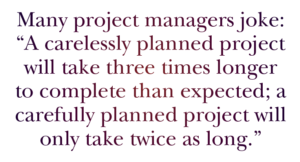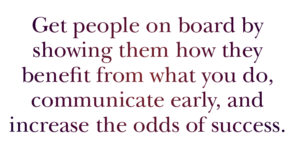By Bernard Aschwanden | STC Associate Fellow

Leveraging for Success
Teamwork and sports: The analogies can be endless. Athletes count on teammates to know what needs to be done, what each player brings to the field, and how to make the most of each other’s skills and abilities to achieve shared success. It’s always easier to succeed when you see someone doing things right, and you adapt it to improve your own game.
Content is the same. Writers, engineers, illustrators, translators, and managers work together to achieve a shared goal. When technical communicators know what others do (and how they do it) we can apply their best practices to our approach to the game. Everyone wins!
Technical communicators should leverage project management best practices. We can learn the project game from those who play it best; then apply it to what we do every day. Let’s take a few cues from the project management playbook and apply their “Knowledge Areas” to technical communications.
Project Management Best Practices
The Project Management Body of Knowledge (PMBOK) identifies 10 Knowledge Areas that lead to success in project management. Included is the management of integration, scope, time, cost, quality, human resources, communications, risk, procurement, and stakeholders. It sounds like a lot to manage for one project, but success or failure can hinge on any one of these areas. The good news is, you’re probably already managing much of this in your own tech comm projects, even if you don’t realize it. Check out Vivian Aschwanden’s article “Parlez-vous PM? How Learning the Language of Project Management Can Enhance Your Tech Comm Toolkit” (page 4) to learn how every project is a content project.
Let’s explore these Knowledge Areas individually, examine how they might relate to us in tech comm, and learn how best to manage them to realize greater success in our own projects.
Integration Management
Integration management deals with handling the day-to-day choices that arise in a project, determining where to place resources and effort, and identifying and addressing issues as they arise. As a technical communicator, you’ll achieve successful integration management when you can pull together all the activities surrounding your documentation project (especially the activities laid out in these Knowledge Areas) and keep the project moving forward. A great way to visualize this is to imagine a juggler keeping multiple balls in the air. Each ball must be coordinated with respect to the other balls so that the whole presentation can continue smoothly.
Scope Management
The scope is everything included in the project and—importantly—nothing that isn’t. For good scope management, it’s critical not only to define the boundaries of the project, but to protect those boundaries in order to keep the project on track. Documentation projects should have clearly defined requirements that we can build the scope from, determining what is and isn’t included. For any project, scope is an important element to agree upon early—and in writing—to avoid scope creep later in the project. Consider a documentation outline to create a framework for the content that goes into a manual. Once broad agreement is reached, you can avoid revisiting changes when someone—often days, weeks, or months later—says “you didn’t include a chapter on hardware upgrades.” You can point back to the plan to identify what was in scope, request more budget if it’s a necessary addition, defer if it’s not crucial, or adjust in some cooperative way.
Time Management
Time management keeps the project on schedule for on-time delivery. For documentation projects, this could include identifying the activities to accomplish, sequencing them, determining required resources, estimating time requirements, and scheduling the activities. Success comes from planning an appropriate timeline that anticipates the impacts of the varying time zones and workdays of your global team, foreign and domestic holidays, training needs, and other factors.
It’s worth noting that building an appropriate timeline can only be accomplished once other areas of the project—such as scope and procurement management—have been clearly defined. Even then, it’s always good to keep in mind one of the oh-so-humorous (yet somehow frustratingly accurate), broadly used, and never attributed Laws of Project Management: “A carelessly planned project will take three times longer to complete than expected; a carefully planned project will only take twice as long.”
 Cost Management
Cost Management
How can you complete the project within the approved budget? With cost management. effective cost management starts with estimating expenses, establishing a budget, and controlling expenses throughout the project. Remember, costs are not just money, but hours, resources, and other things with a finite availability. However, as most of us know, managing costs is rarely clear cut. Sometimes we estimate costs right from the start that exceed our approved budget, forcing us to make tough decisions. Sometimes external factors or unexpected developments impact costs along the project timeline. For documentation projects specifically, we must determine how our approved budget will work across all aspects of the project, such as lifecycle costs and ongoing tech support expenses. We must also anticipate the places where our project might experience variances. Are we working with a risky client who is known to change scope mid-project? Are we limiting design review to stay within budget, only to realize added expense later in the form of support or revisions? Ultimately, cost management involves coordination with and consideration of most other key Knowledge Areas.
Quality Management
The primary goal of quality management is to ensure a project has met the objectives it initially set out to do. For documentation projects, this can be achieved by:
- Identifying quality standards relevant to the project
- Applying those standards consistently
- Monitoring results for compliance
- Adjusting as necessary
Quality standards can come from within an organization, from the customer, or a combination of both. Once they have been identified, they should be applied throughout the project and should be tracked and measured to monitor compliance. For example, if you have a large, long-term document conversion project, you and your customer would likely agree on a certain number of chapters to be converted every month. This goal should be worked into the project timeline, tracked, and documented. Doing so ensures that you and your customer can assess whether you are meeting your objectives and adjust as needed. Quality management is a process that should become integral to our project planning and execution. If we don’t consistently set and maintain quality standards, we run the very real risk of falling short in some, if not all, of the key Knowledge Areas we’re discussing today.
Human Resource Management
The humans involved with your project are a finite resource. Spearheading human resource management from the onset of a project helps to manage expectations and build trust among the team. Planning should occur early, and include:
- Identifying roles and responsibilities
- Clarifying reporting structure
- Ensuring the right people are on the team
- Providing training as needed
- Tracking performance
These are important concerns whether the project is big or small. Even if you’re a “team” of one, you and your customer will still need to come to agreement on such things as roles and responsibilities, and potential training needs (which could impact both time and cost for the project). On a larger team, clarification of the reporting structure becomes critical, as does ensuring that you’ve got the right people available for the work ahead.
Communications Management
Communications management ensures that project information is appropriately handled with respect to the project phase, from creation to disposition and everything in between. This includes such things as collecting, distributing, storing, and retrieving relevant project information. We often think of communications only in terms of our project deliverables, but we also need to practice good communication with our teams while we’re creating. This starts with determining who the stakeholders are and what information they need. Then, we communicate regularly with those stakeholders, and we don’t stop until their expectations are met. This should be an ongoing process throughout the project; it leads to fewer surprises and can reduce negative impacts such as change requests, calls for overtime, and quality complaints. Open and ongoing communications management is a key element in keeping projects on track.
Risk Management
Risk management involves identifying uncertainties or conditions that could affect your project, and taking steps to reduce their impact if they occur. To practice risk management, determine what risks might affect your project and prioritize them based on probability and potential impact. Analyze the effect they will have on the project and develop appropriate responses to mitigate that effect. Then, throughout the project, monitor these potential risks and execute your response plan(s) if necessary.
One example of risk management is allocating a certain percentage of the project’s budget to cover unexpected expenses. (If you end up not needing to use those funds, congratulations, you just managed risk well enough to come in under budget. Pizza party!)
Procurement Management
Procurement management deals with the acquisition of external products or services necessary for project success. For documentation projects, this could include new software or hardware, additional training, hiring a consultant, or perhaps outsourcing some specialized work. Procurement activity will have an impact on the project’s timeline and cost, so proper management is essential. It’s good to have an idea of where these resources may be found. In my experience, membership in STC, and attending networking and educational events like STC’s Technical Communication Summit, are a great way to build a list of resources to keep in your back pocket.
Stakeholder Management
For project management, this key Knowledge Area is of utmost importance. Stakeholder management refers to the maintenance of relationships with both internal and external stakeholders to garner and sustain support for projects. Once stakeholders are identified, they should be kept actively engaged in the project; this increases collaboration and reduces risk.
The overall success of a project will increase if more people within an organization—especially those at the executive level—buy into the project and actively engage in its progress. Consider just how relevant to your documentation work the following project management quotes are! Bob Roark, PMP, Executive Solutions Strategist for Cherwell Software in Denver, Colorado, says in Pulse of the Profession, 2020, “If people start understanding ‘what’s in it for me,’ then they’ll get there faster.” Mr. Roark also stresses the need to communicate with stakeholders from the start, adding that “If you [communicate] behind the change, it’s an uphill battle no matter what you do.” Sound familiar? Get people on board by showing them how they benefit from what you do, communicate early, and increase the odds of success.
 Certification
Certification
Aside from the wealth of knowledge we can learn from examining PMBOK’s 10 Knowledge Areas and how they relate to tech comm, there’s one other similarity between these two fields: certification. In the world of project management, this is huge. Many leaders in the industry believe certification is highly relevant for mid-career project managers; if that sounds a bit familiar to you in the tech comm world, it’s no surprise. STC provides certification too, and as the program grows it becomes more crucial to success within our industry. For those who are new to mid-level in tech comm, STC certification is an ideal to pursue. In both cases, certification offers independent proof that you have a clear grasp on the fundamentals of the profession.
In Summary
Best practices from the field of project management offer great insight into ways technical communicators can improve what we do, and how we do it. The overlap that exists between the two fields makes it easier for technical communicators to recognize the value of those best practices in our day-to-day work.
One thing that you likely noticed about PMBOK’s key Knowledge Areas is the overlap that also exists between them. Some are so intertwined that one cannot realistically be effective without the other. It’s easy to understand, for example, the value of procurement management when you realize the impact it has on cost and time management. You likely already pursue at least some of these best practices in your own workplace; ideally, we as technical communicators will find even more ways to leverage these techniques for success. In addition to PMBOK’s 10 key Knowledge Areas, its elevation of certification credentials is something we can draw from as an example of how to advance the profession of technical communication.
Just like the fundamentals of sports are transferable (an athlete who is fit, versed in the rules of the game, has good hand-eye coordination, knows the positions of the other players, and plays well on a team with others can likely find a core of success regardless of the sport), so too are the fundamentals of technical communication and project management. The more we learn about how others who are part of our team think and act, the easier it is for us to adjust what we do to help them succeed. As we see what drives their success, we can apply it to our own position on the team. Managers of projects, managers of documentation. Writers of project plans, writers of documentation plans. Successful implementation means developing our skills, following core rules, and building trust with our teammates. Let’s get in the game!
BERNARD ASCHWANDEN (bernard.aschwanden@publishingsmarter.com) solves documentation-based problems and helps companies generate more revenue. He guides clients through the best processes to create, manage, and deliver content, and has helped hundreds of companies implement successful solutions. He is focused on publishing better, publishing faster, and publishing smarter. Bernard is the founder of Publishing Smarter, and is an Associate Fellow of STC, and a Past President of STC.
References
Project Management Institute (PMI). 2020. “Pulse of the Profession.” Accessed 3 March 2021. https://www.pmi.org/learning/thought-leadership/pulse/pulse-of-the-profession-2020.
Project Management Institute (PMI). n.d. “PMBOK Guide and Standards.” Accessed 3 March 2021. https://www.pmi.org/pmbok-guide-standards.
Society for Technical Communication. n.d.” STC Certification.” Accessed 3 March 2021. https://www.stc.org/become-cptc-certified/.
Aschwanden, Vivian. 2021. “Parlez-vous PM? How Learning the Language of Project Management Can Enhance Your Tech Comm Toolkit.” STC Intercomm. 68 no. 2: 4-8.


